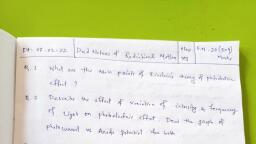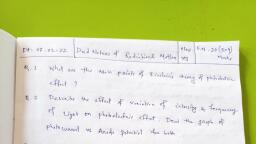Question 1 :
Electrons used in an electron microscope are accelerated by a voltage of $25$ kV. If the voltage is increased to $100$ kV then the de-Broglie wavelength associated with the electrons would?
Question 2 :
Maximum velocity of photoelectron emitted is $4.8\,m/s$. If e/m ratio of electron is $1.76 \times { 10 }^{  11}  C\,kg^{-1}$, then stopping potential is given by :
Question 3 :
The work function of a photosensitive element is 2eV. Then the velocity of a photoelectron when the element is exposed to a light of wavelength of $4\times10^{3}A^{0} (h=6.63\times 10^{-34}J-s$ and $c=3\times 10^{8}m/s,m=9.1\times 10^{-31}Kg)$<br/>
Question 4 :
The energy that should be added to an electron to reduce its de broglie wavelength from 1 nm to 0.5 nm is
Question 5 :
Which of the following does not support the wave nature of light?
Question 6 :
If the intensity of radiation incident on a photocell be increased four times, then the number of photoelectrons and the energy of photoelectrons emitted respectively become<br>
Question 8 :
The de Broglie wavelength of an electron (mass = $1 \times 10^{-30}$ kg, charge = $1.6 \times 10^{-1} C$) with a kinetic energy of 200 eV is (Planck's constant = $6.6 \times 10^{-34} J s$)
Question 9 :
A radiation of energy $E$ falls normally on a perfectly reflecting surface. The momentun transferred to the surface is
Question 10 :
Light of wave length 5000 Angstrom falls on a sensitive plate with photoelectric work function of 1.9 eV. The maximum kinetic energy of the photo electron emitted will be..
Question 11 :
Assertion: Photoelectric effect demonstrates the wave nature of light.
Reason: The number of photoelectrons is proportional to the frequency of light.
Question 12 :
In the photoelectric phenomenon if the ratio of the frequency of incident radiation incident on a photosensitive surface is $1 : 2 : 3$, the ratio of the photo electric current is
Question 13 :
Which of the following particles - neutron, proton,electron and deuteron has the lowest energy if all have the same de Broglie wavelength:<br/>
Question 14 :
Mercury violet light $(\lambda =4558\overset {o}{A})$ is falling on a photosensitive material $(\phi =2.5\ eV)$. The speed of the ejected electrons is in $ms^{-1}$ about<br>
Question 15 :
The wavelength $\lambda_{e}$ of an electron and $\lambda_{p}$ of a photon of same energy $E$ are related by<br>
Question 16 :
Two radiations of photons energies 1 eV and 2.5 eV, successively illuminate a photosensitive metallic<br/>surface of work function 0.5 eV. The ratio of the maximum speeds of the emitted electrons is:<br/>
Question 18 :
The threshold frequency for certain metal is $3.3\times { 10 }^{ 14 } Hz$. If light of $8.2\times { 10 }^{ 14 }Hz$ frequency is incident on the metal, then the cut-off voltage of the photoelectric current will be :<br/>
Question 19 :
De-Broglie wavelength associated with thermal neutrons at room temperature of $27^{0}$C is :
Question 20 :
A monochromatic source of light operating at 200 W emits $4 \times 10^{20}$ photons/second. Then the wavelength of light used is<br/>
Question 21 :
The energy of a photon is $3\times{10}^{-12}$ ergs. What is its wavelength in $nm$ ? <br/>$[h=6.62 \times 10^{-27}\ erg,\ c=3\times 10^{10}\ cm/s]$
Question 22 :
The work function of a metal surface is 1 eV. A light of wavelength 3000$A^{0}$ is incident on it. The maximum velocity of the photo-electrons is nearly<br/>
Question 23 :
If alpha particle, proton and electron move with the same momentum, then their respective de-Broglie wavelengths ${ \lambda }_{ \alpha },{ \lambda }_{ p },{ \lambda }_{ e }$ are related as
Question 24 :
The kinetic energy of an electron get tripled then the de-Broglie wavelength associated with electron changes by a factor of






























